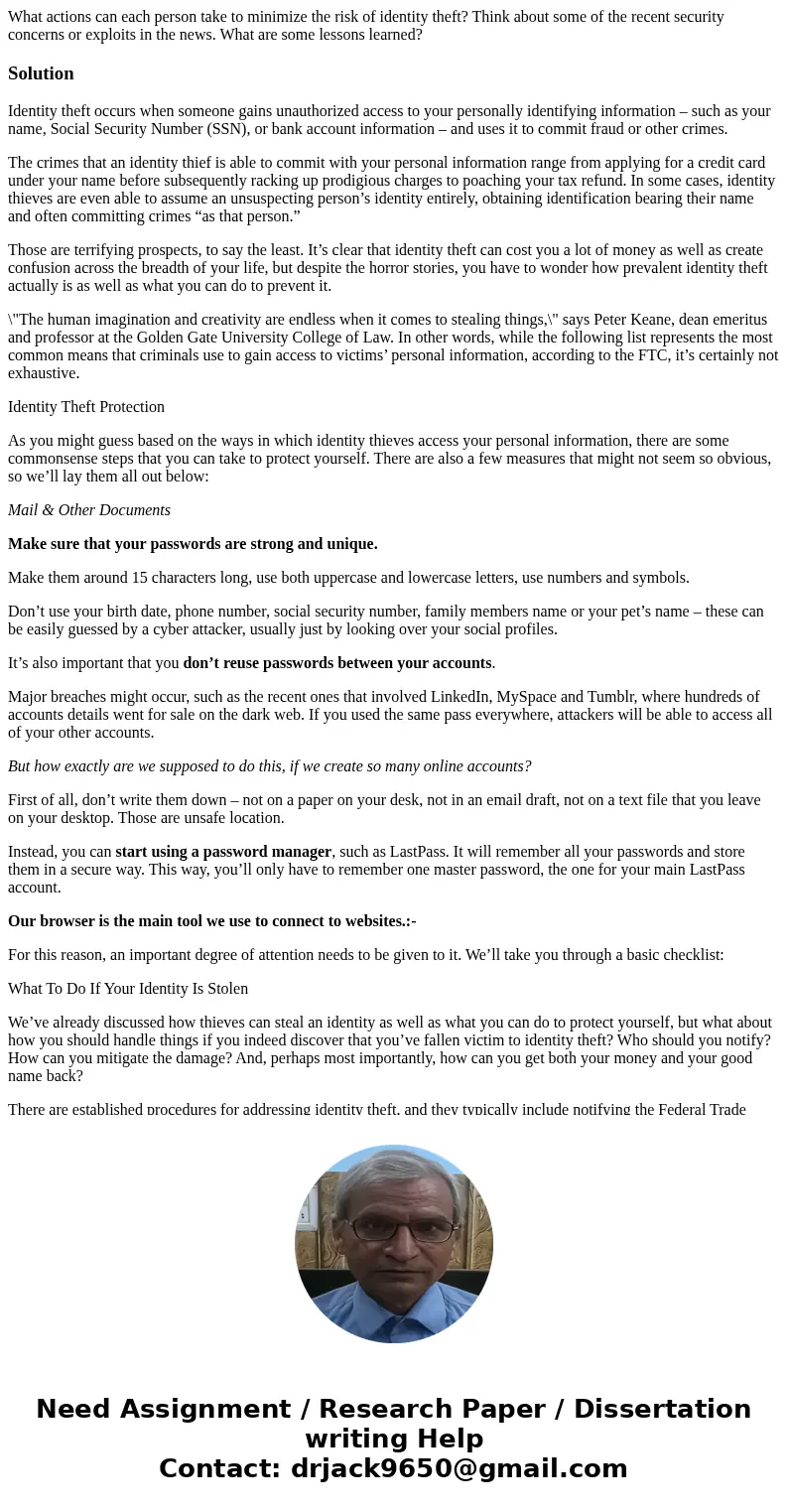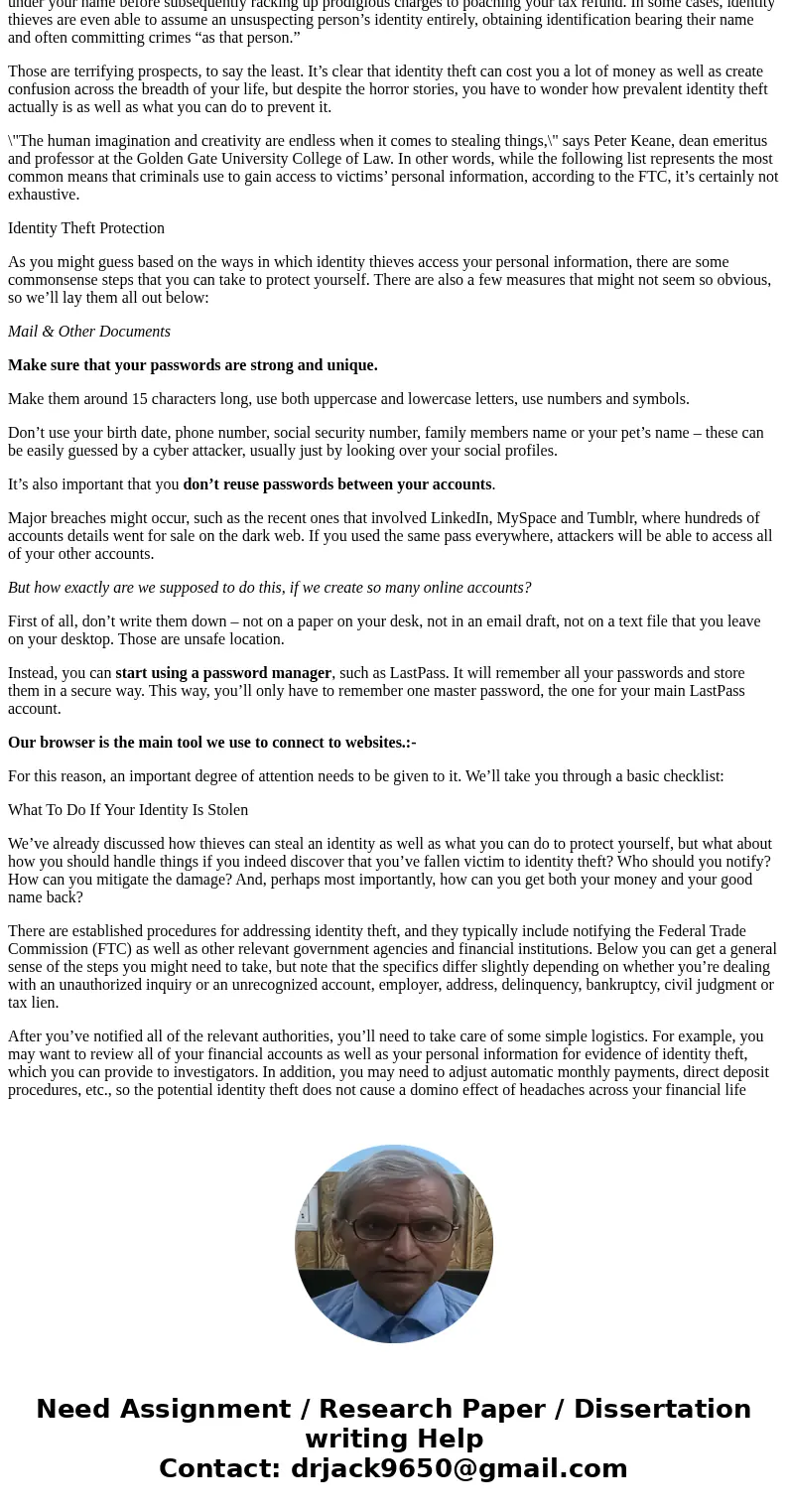What actions can each person take to minimize the risk of id
What actions can each person take to minimize the risk of identity theft? Think about some of the recent security concerns or exploits in the news. What are some lessons learned?
Solution
Identity theft occurs when someone gains unauthorized access to your personally identifying information – such as your name, Social Security Number (SSN), or bank account information – and uses it to commit fraud or other crimes.
The crimes that an identity thief is able to commit with your personal information range from applying for a credit card under your name before subsequently racking up prodigious charges to poaching your tax refund. In some cases, identity thieves are even able to assume an unsuspecting person’s identity entirely, obtaining identification bearing their name and often committing crimes “as that person.”
Those are terrifying prospects, to say the least. It’s clear that identity theft can cost you a lot of money as well as create confusion across the breadth of your life, but despite the horror stories, you have to wonder how prevalent identity theft actually is as well as what you can do to prevent it.
\"The human imagination and creativity are endless when it comes to stealing things,\" says Peter Keane, dean emeritus and professor at the Golden Gate University College of Law. In other words, while the following list represents the most common means that criminals use to gain access to victims’ personal information, according to the FTC, it’s certainly not exhaustive.
Identity Theft Protection
As you might guess based on the ways in which identity thieves access your personal information, there are some commonsense steps that you can take to protect yourself. There are also a few measures that might not seem so obvious, so we’ll lay them all out below:
Mail & Other Documents
Make sure that your passwords are strong and unique.
Make them around 15 characters long, use both uppercase and lowercase letters, use numbers and symbols.
Don’t use your birth date, phone number, social security number, family members name or your pet’s name – these can be easily guessed by a cyber attacker, usually just by looking over your social profiles.
It’s also important that you don’t reuse passwords between your accounts.
Major breaches might occur, such as the recent ones that involved LinkedIn, MySpace and Tumblr, where hundreds of accounts details went for sale on the dark web. If you used the same pass everywhere, attackers will be able to access all of your other accounts.
But how exactly are we supposed to do this, if we create so many online accounts?
First of all, don’t write them down – not on a paper on your desk, not in an email draft, not on a text file that you leave on your desktop. Those are unsafe location.
Instead, you can start using a password manager, such as LastPass. It will remember all your passwords and store them in a secure way. This way, you’ll only have to remember one master password, the one for your main LastPass account.
Our browser is the main tool we use to connect to websites.:-
For this reason, an important degree of attention needs to be given to it. We’ll take you through a basic checklist:
What To Do If Your Identity Is Stolen
We’ve already discussed how thieves can steal an identity as well as what you can do to protect yourself, but what about how you should handle things if you indeed discover that you’ve fallen victim to identity theft? Who should you notify? How can you mitigate the damage? And, perhaps most importantly, how can you get both your money and your good name back?
There are established procedures for addressing identity theft, and they typically include notifying the Federal Trade Commission (FTC) as well as other relevant government agencies and financial institutions. Below you can get a general sense of the steps you might need to take, but note that the specifics differ slightly depending on whether you’re dealing with an unauthorized inquiry or an unrecognized account, employer, address, delinquency, bankruptcy, civil judgment or tax lien.
After you’ve notified all of the relevant authorities, you’ll need to take care of some simple logistics. For example, you may want to review all of your financial accounts as well as your personal information for evidence of identity theft, which you can provide to investigators. In addition, you may need to adjust automatic monthly payments, direct deposit procedures, etc., so the potential identity theft does not cause a domino effect of headaches across your financial life


 Homework Sourse
Homework Sourse